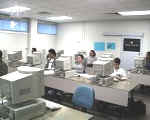| Computer Assisted Learning | ||
|
CAL stands for Computer Assisted Learning. CAL courses may use ...
CAL systems use interactive computing.
|
You are using CAL right now! | |
Benefits of CAL...
|
 |
|
|
|
Pupils generally learn better when they study on their own and can learn at their own pace. | |
| CBT = Computer
Based Training - Using the computer as an instructor. CBT may
include tutorials, practice exercises
and feedback on the student's
learning progress.
|
||
| Virtual
Reality
systems are being developed where the user puts on a helmet which
projects images into the eyes using small computer screens, and a virtual
reality glove which inputs the users hand movements.
Although great for computer games, there are serious uses as well. VR systems are being developed to help student surgeons; a CAT (Computer Aided Tomography) scan can create a 3-dimensional picture of the human body. A surgeon can put on a VR helmet and feel as if he is walking around inside the patient! He can view eg a tumour from different angles etc..
|
||


